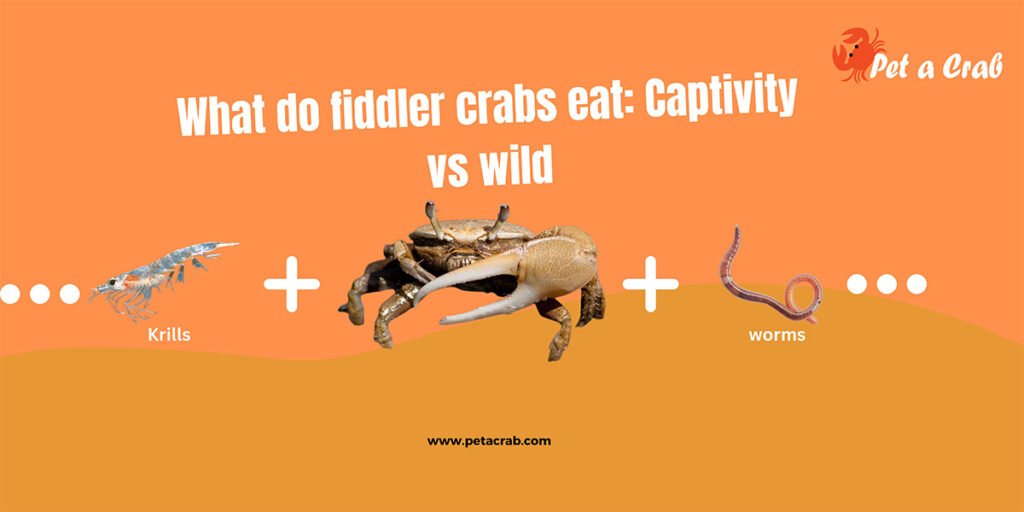Before buying hermit crabs, you have to think about the setup of the tank. Hermit crab have some specific necessities, they need some specific object in the enclosure to thrive happily and healthily. Here we’re going to learn about the requirements that hermit crabs need in their cage.
We are going to divide the elements into two parts.
- Necessary elements for hermit crabs tank
- Optional elements for the tank
Let’s dive into the process.
What do hermit crabs need in their cage?
The main elements are a tank, eco earth, heating mat, shells, wood, water bowl, hiding places, ladder, dry almond leaves, food, salt and freshwater, and many other things.
Necessary elements for hermit crabs tank
These elements should not be skipped when setting up the tank. You can find all of these products on Amazon.
Tank
Hermit crabs have a specific space requirements. They do not like crowded places. However, hermit crabs are social animals. They like to play around and like to live as a group. So, to make a healthy enclosure you need to keep at least 2 crabs in one tank.
20 gallons tank per pair or a minimum of 10 gallons for two hermit crabs.
Eco Earth
This is the most commonly used substrate in hermit crabs’ habitat. This is made of coconut fiber, that is considered as a good substrate for a hermit crab habitat. Make sure to moisten the substrate with dechlorinated tap water.
Pour three times as deep as the largest hermit crab you are going to put (6 inches minimum). Because they like to bury themselves, especially in the time of molting.
Heating mat
Controlled temperature is crucial for hermit crabs’ health. Otherwise, they will be lazy, inactive, and sick. They need warm temperature, usually between 24 and 29°C. The heat mat ensures warmer air and substrate temperature is controlled.
Thermometer
A thermometer will help you inspect the temperature, and make decisions to keep the temperature in an ideal range.
Hygrometer
Hermit crabs need a humid environment within the range of So controlling the humidity level is crucial as their body is vulnerable and can get affected by the dry air.
A hygrometer will help you monitor the humidity level and help you ensure that the environment remains within the recommended range.
Mister spray bottle
A mister spray bottle will need to set the recommended humidity. If you see the humidity level fall under 70% to 80%, you will spray some water. There are other things you can do to control humidity but that is optional. We’ll talk about it later.
Wood
Putting wood into the enclosure is up to you. You can use any size and shape of wood you want. But try to use wood that will serve as a hiding purpose for the crabs. You can find variable sizes of wood in local stores and online stores.
Before adding wood or any other elements, boil them for a minimum of one to two minutes.
Hiding place
Hermit crabs need hiding places as they like to play around and hide most of the time. You can make their hiding place with anything such as wood or any other crafted things like mossy cave hideouts, cholla wood, clay pots, Spongebob’s pineapple house, and castle crib.
You will find many different sizes and shapes of hideouts online.
Wooden log half-pipe
Log half-pipe is considered a mandatory element for hermit crabs’ hiding place as it can keep the cave moist and humid. You can skip this if you have enough hiding places. But keeping one in a tank is a minimum requirement.
Shell
As hermit crabs grow they need to change the old shell and find a new one that fits most. Shells are like clothes to them. Give them different sizes of shell minimum 3 for one crab. Ensure the painted color is non-toxic if you use the painted shell. Make them bacteria and parasite-free by boiling them for two minutes (boiling shells can be extremely hot, grab them with a pincher) and place them upside down after cooling.
Water and food bowls
You can find many types of water bowls online. Choose what you like to keep. Search with “hermit crab bowl.” Buy three different types of bowls two for water and one for food place them where you like. Two corner bowls and one bowl in the middle look nice in a hermit crab territory.
Water
You may ask what the purpose of two water bowls is. Hermit crabs need to access both freshwater and saltwater to stay hydrated and maintain their overall health. The two water bowls typically contain one with freshwater and the other with a mixture of marine salt and freshwater to create a suitable saltwater environment. Enough water also keeps the territory humid.
Dechlorinate the tap water before pouring the bowl.
Food
Hermit crabs are omnivorous means they can eat everything from veggies and fruits to meat. Ensure the food is healthy and contains all the nutrition they need. Give calcium-rich food during molting time, it helps to form a new exoskeleton
Optional elements for the tank
Adding these elements is not mandatory but will be beneficial.
Sand
Many people recommend using half eco earth and half sand mixture as substrate. There can be found many hermit crab sand.
Catappa leaves
Dried Indian almond / catappa leaves on the substrate surface can be a great addition. Hermit crabs love dried leaves to hide themselves. These leaves also help the substrate to retain moisture.
Humidifier
You can use a humidifier instead of a mister bottle to keep the territory humid.
Coconut fiber climbing carpet
Coco fiber carpet increases the area of playing around. Hermit loves to climb things and as they can’t climb glass or plastic this carpet will help to do that. You can replace this by using a pet ladder.
Aquarium plants
It is hard to find live aquarium plants you can keep one or two to mimic the natural habitat. Hermit crabs will love them.
Plastic plant is used most of the time in a hermit crab enclosure.
Light
If you place the tank in a sunny area or somewhere the tank can get enough daylight there is no reason for bulbs. But if the tank is always kept in a dark room, you should use a clamp lamp with a UVB bulb. UVB is not essential for hermit crabs but they get vitamin D3 and improved exoskeleton color from light.
Ensure the tank gets a regular cycle of day and night with artificial light. You can use a UV black light to see crabs’ movements as they are more active at night. Know more about light.


